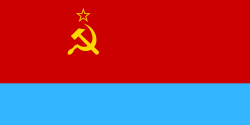History
Before this 1919 flag, a flag in 1918 was used with red and blue, with yellow stripes in the canton.
The first flag was red with the gold Cyrillic sans-serif letters У.С.С.Р. (USSR, acronym for Ukrayinskaya Sotsialisticheskaya Sovetskaya Respublika (Ukrainian Socialist Soviet Republic) in the Russian language). A decade later, the Ukrainian initials У.С.Р.Р. appeared (USRR, for Ukrayinsʹka Sotsialistychna Radyansʹka Respublika). In the 1930s a gold border was added. In 1937, a new flag was adopted, with a small gold hammer and sickle added above the gold Cyrillic serif letters УРСР (the name had changed, transposing the second and third words).
Flag of the
Ukrainian PRS (1917–1918)
Flag of the
Ukrainian SR (1918)
Flag of the Ukrainian SSR (1919–1929)
Flag of the Ukrainian SSR (1929–1937)
Flag of the Ukrainian SSR (1937–1950)
The Soviet Union and two of its republics (Ukraine and Byelorussia) all became members of the nascent United Nations (UN) in 1945. Since all of their flags were red with only small markings in the upper left corner, the UN demanded changes to the flags in 1949. [2] To comply, the Ukrainian Soviet authorities dropped the lettering and added an azure horizontal stripe (1⁄3 of the width). The Ukrainian SSR adopted this new design as its official flag on 5 July 1950. [3] Other constituent republics of the Soviet Union soon followed suit and customised the bottom third of their flags. [2]
While the Soviet flag was flown in the later months of 1991, even after the failed coup d'état, the blue and yellow flag, even though it was a criminal offense under the Soviet law, was raised spontaneously throughout Ukraine by local activists between 14 March 1990 beginning at town of Stryi until the country's independence on 24 August 1991. The blue and yellow flag was provisionally adopted for official ceremonies in September 1991, although the Soviet-era flag officially remained until it was replaced on 28 January 1992. [4]
This page is based on this
Wikipedia article Text is available under the
CC BY-SA 4.0 license; additional terms may apply.
Images, videos and audio are available under their respective licenses.













